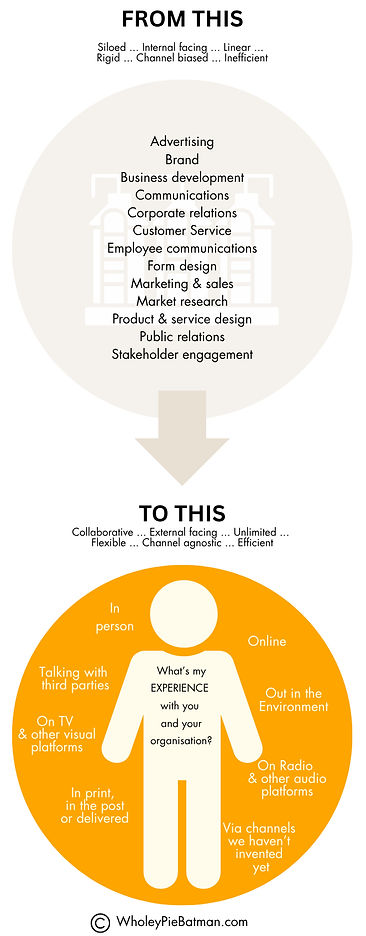
"The single biggest problem in
communication is the illusion it has taken place." GEORGE BERNARD SHAW
Imagine, for a moment, that you are 'people' too.
Go on, pull off those professional shoes, put on your just-another-human-being shoes and go for a stroll. Think about your own experiences shopping, making an enquiry, trying to find something, completing a form ... whether in the digital or real world.

We want the same experience, no matter which 'doorway' we use
We don't care or need to know how a business is organised internally. We don't think in terms of channels. We just want to get what we came for and have the same experience whenever we engage with an organisation, no matter what channel we use. If we have different experiences on different channels, or if different channels are not linked, we feel a sense of disorientation, uncertainty and frustration which undermine our trust.

We don't use channels in a linear way, we have freedom!
We don't operate within single channels. We go where we want, when we want. We misbehave. Most of us use at least two channels in our interactions with an organisation. And if we are restricted (even if lovingly), we rebel ... because we can. We have options.

We have high expectations
of what a fast and easy service is.
Organisations that use those words lose our respect quickly if the experience doesn't match up. We have experienced fast and easy services so we know it can be done. We will find inspirations that shape our expectations like Dieter Ram's 10 Principles of Good Design and then email them to customer service teams as thoughtful suggestions :) How often have you wondered if staff in an organisation ever actually use their own channels?

We have power and influence
We have greater control than ever before about what reaches us, what we can avoid and what captures our imagination. We defy previously-defined social, geographic and economic demographics. Many of us, of all ages and backgrounds, are now in the digital-savvy segment dubbed Generation C. It's all about creativity, community, co-creation, connectedness, channel convergence and control. We're can build our own websites and social networks, reach many people with our rating of products and take photos and videos that drive news headlines.
It's all about the human experience

So, when you think about your marketing communications, start by thinking about the experience you want people to have
-3_edited.jpg)
When you do, you start to see how all the moving parts, like content, channels, campaigns and customer service, can work together to give people a consistently-positive experience no matter which 'doorway' they use along THEIR pathway.
A positive experience that people will like (maybe even love), make a part of their world at home or at work, and share with family, friends and colleagues.
This type of thinking is called Integrated Marketing Communications (with a large dollop of inclusive design thrown in). It's how I work, and it's how you can:
-
remove inefficient, old boundaries and silos that are costing you time and money
-
make doing business with you easier
-
make a large organisation accessible and welcoming OR make a small business popular and robust
-
give people confidence and trust in your organisation and build brand loyalty
-
increase the number of people your business can reach and engage
-
realise the full value of your marketing communication spend
But by far the most-compelling reason to use it is that it's what people want and expect.
It's not a new approach. In fact it's been around for a long time. As far back as 2013, a survey by Avi Dan showed 68% of 1,850 US Chief Marketing Officers put integrated marketing communication ahead of 'effective advertising'.
Common sense but not always common practice - it's primarily younger businesses, free of legacy and silo thinking, making the most of it.
But that's changing. We now operate in an increasingly complex marketing environment, characterised by an explosion of channels, converged technologies and consumer control.
You can chose to see this as a risk or an opportunity. Either way, IMC principles and practice are viewed as critical success factors.